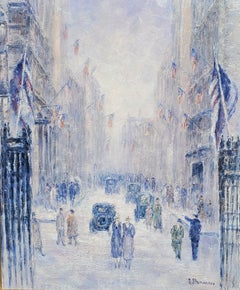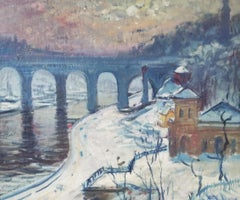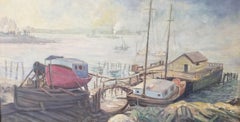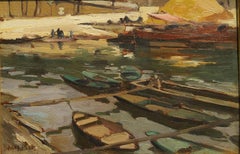Want more images or videos?
Request additional images or videos from the seller
1 of 8
William Merritt PostAutumn Landscape
$6,500List Price
About the Item
- Creator:William Merritt Post (1856 - 1935, American)
- Dimensions:Height: 10 in (25.4 cm)Width: 14 in (35.56 cm)Depth: 2 in (5.08 cm)
- Medium:
- Movement & Style:
- Period:
- Condition:
- Gallery Location:Saratoga Springs, NY
- Reference Number:1stDibs: LU170212937922
About the Seller
4.2
Vetted Professional Seller
Every seller passes strict standards for authenticity and reliability
Established in 1992
1stDibs seller since 2015
31 sales on 1stDibs
Typical response time: 17 hours
Authenticity Guarantee
In the unlikely event there’s an issue with an item’s authenticity, contact us within 1 year for a full refund. DetailsMoney-Back Guarantee
If your item is not as described, is damaged in transit, or does not arrive, contact us within 7 days for a full refund. Details24-Hour Cancellation
You have a 24-hour grace period in which to reconsider your purchase, with no questions asked.Vetted Professional Sellers
Our world-class sellers must adhere to strict standards for service and quality, maintaining the integrity of our listings.Price-Match Guarantee
If you find that a seller listed the same item for a lower price elsewhere, we’ll match it.Trusted Global Delivery
Our best-in-class carrier network provides specialized shipping options worldwide, including custom delivery.You May Also Like
"Sailboat by the Marina" Colorful Coastal Impressionist Oil Painting Framed
Located in New York, NY
A jewel of a piece, the coast with sails in the distance as figures walk along the waters edge. This impressionist scene boasts a calm view with mountains in the background and palm ...
Category
Early 20th Century American Impressionist Landscape Paintings
Materials
Oil, Board
$400 Sale Price
20% Off
H 11 in W 13.5 in D 1 in
American School Farmhouse, 20th Century
Located in New York, NY
Mystery Artist
Untitled (Farmhouse), c. Early 20th Century
Oil on board
8 1/2 x 17 in.
Framed: 14 7/8 x 23 3/8 x 3/4 in.
Category
Early 20th Century American Impressionist Landscape Paintings
Materials
Oil, Board
"The Lobster Boats at Gloucester" Impressionistic Maritime Oil Painting
Located in Soquel, CA
"The Lobster Boats at Gloucester" Impressionistic Maritime Oil Painting
Vibrant and lively painting of moored lobster fishing boats by F. Pileria Sunnyvale, California artist. Two l...
Category
Late 20th Century American Impressionist Landscape Paintings
Materials
Canvas, Oil, Board
$950
H 28.25 in W 34.5 in D 2.5 in
Napa County Sunset Landscape
Located in Soquel, CA
Vibrant landscape of a purple sunset over a Napa County country road bathed in golden light, by an unknown California artist (American, 20th Century). In style of artists from Ovanne...
Category
Late 20th Century American Impressionist Landscape Paintings
Materials
Canvas, Oil, Foam Board
Mid Century Landscape -- Homestead Beneath a Desert Mountain
By Alice M. Fink
Located in Soquel, CA
Sweeping mid century landscape of a lone house in an expansive desert scene with colossal mountains in the distance by Alice M. Fink (American, 1880-1968). Signed "Alice M. Fink" low...
Category
1960s American Impressionist Landscape Paintings
Materials
Canvas, Oil, Cardboard
$316 Sale Price
20% Off
H 12 in W 16 in D 1 in
Hillside Landscape
Located in Soquel, CA
Misty and verdant small-scale landscape by an unknown artist ("CMK"). The composition of the hillside in this landscape creates a diagonal across the canvas, bringing more visual int...
Category
1990s American Impressionist Landscape Paintings
Materials
Canvas, Oil, Cardboard
Mid Century Carmel Valley Figurative Landscape -- The Roadside Grocer
By Edda Maxwell Heath
Located in Soquel, CA
Gorgeous figurative landscape of a Carmel roadside grocer by Edda Maxwell Heath (American, 1874 - 1972). Signed and dated lower left corner. Presented in giltwood frame. Image, 20"H ...
Category
1950s American Impressionist Landscape Paintings
Materials
Oil, Illustration Board
$2,800 Sale Price
20% Off
H 27.5 in W 31.5 in D 1.25 in
Snowy Peak, California Sierra Mountain Landscape
By Kenneth Lucas
Located in Soquel, CA
Striking vertical landscape of a dramatic rocky mountain peak towering above the tree line by Ken Lucas (American, 20th Century). "Ken Lucas" and "#33 March 3, 1993" are written on ...
Category
1990s American Impressionist Landscape Paintings
Materials
Canvas, Oil, Cardboard
$588 Sale Price
20% Off
H 29.13 in W 23 in D 1.75 in
"Sundown" Western Shoot Out, Mid Century Figurative Action Scene
Located in Soquel, CA
A dramatic mid-century western figurative action scene depicting a shootout in an old western town by Randy Steffen (American, 1917-1977), 1947. Several ...
Category
1940s American Impressionist Figurative Paintings
Materials
Oil, Fiberboard
$1,200 Sale Price
20% Off
H 28.25 in W 22.25 in D 1.25 in
Golden Tree Landscape
Located in Soquel, CA
Enchanting oil painting of a glowing textured tree layered with gold leaf and deep purples by an unknown artist (American, 20th Century). Unsigned. Painted on heavy 1/4" artists boa...
Category
Late 20th Century American Impressionist Landscape Paintings
Materials
Gold Leaf
More From This Seller
View AllWall Street New York
By Gail Sherman Corbett
Located in Saratoga Springs, NY
Signed lower right.
Category
Mid-20th Century American Impressionist Figurative Paintings
Materials
Canvas, Oil
High Bridge, New York
By Arthur Clifton Goodwin
Located in Saratoga Springs, NY
Signed lower right.
Bio:
A painter especially known for street and waterfront scenes of Boston, Arthur Clifton Goodwin did work that captured the subtle nuances of light and color, ...
Category
Early 20th Century American Impressionist Landscape Paintings
Materials
Canvas, Oil
New York Harbor
By Guy Wiggins
Located in Saratoga Springs, NY
Signed lower right.
Guy Carleton Wiggins adopted the bright palette and lively brushwork of the impressionist movement, and is best known for his New York City snow scenes...
Category
Mid-20th Century American Impressionist Landscape Paintings
Materials
Canvas, Oil
$85,000
Sampans on the Seine River, Paris
By Jules Pages
Located in Saratoga Springs, NY
Signed lower right.
A prominent landscape and marine painter, Jules Eugène Pages spent most of his career in France where he was a well-known Impressionist painter, but he mainta...
Category
Early 1900s Impressionist Landscape Paintings
Materials
Board, Oil
Landscape
Located in Saratoga Springs, NY
Signed lower left
Landscape and figure painter William Partridge Burpee was born in Rockland, Maine on April 13, 1846. As a young man, he was educated in Rockland schools and in the Kents Hill Academy in Readfield, Maine. He exhibited a great deal of interest as a youth in painting and drawing, In the late 1870s, he studied with marine painter, William Bradford (1823-1894). Burpee's early work of the 1880s reflects Bradford's influence as well as other painters such as Martin Johnson Heade, Fitz Hugh Lane, Frederic Edwin Church, A. T. Bricher and F. A. Silva.
After briefly advertising himself as an artist in the Rockland City Directory in 1882, Burpee appeared that year in Boston. By September 1, 1885, he was painting figures on Lynn Beach...
Category
Early 20th Century Impressionist Landscape Paintings
Materials
Oil, Board
$4,500
Brooklyn Bridge, New York
Located in Saratoga Springs, NY
David Solot, a dentist and painter, was born in Falciu (Romania) and
settled in Paris in 1928. His art was surrealistic dentally inspired plus
portraits and city landscapes.
****************************
Translated from an article by Luana Hrisanti Rigot:
"In 1956, at the Charlotte Norberg Gallery (Paris), he presented his first personal exhibition, composed of an ensemble of surrealist paintings of professional inspiration (dental elements). Two years later, at Gallery Royale (Rochefort), he exhibits another 50 paintings on the subject. At that time, a decisive event for the painter David Solot was made: a great new-York-born antibiotic producer Lederle Cy learns about his work and contacts him through the US Ambassador to Paris, proposing an advertising contract and buying the reproduction right for 24 of its canvases. A year later, the same company bought the right to print three of its cloths in color. This was the starting point of his international notoriety.
In 1959, the American Dental...
Category
1960s Impressionist Figurative Paintings
Materials
Oil, Board
Recently Viewed
View AllMore Ways To Browse
19th Century British School
Breton Artists
Country House Paintings
Hastings Antique
Home Sweet Home
M Charles
Oil Painting Ruins
Purple Sunset
Harbor Scene Oil Painting
Sharon Stone
Small Framed Landscapes
Tuscan Painting
Antique Oil Painting Sunset
English Countryside Landscape Art
English Countryside Oil Painting
Farm Sign
Four Seasons Paintings
St Honore



